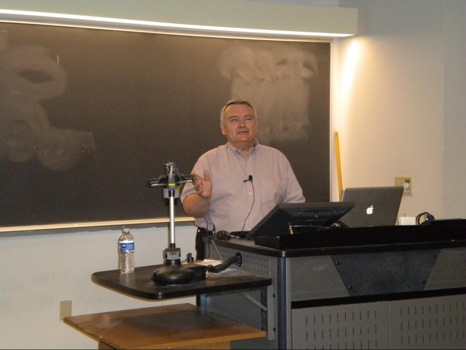The issue with used, formally called spent, nuclear fuel is what to do with it. No politically acceptable process of recycling is available in the United States. Beginning with the Carter Administration, recycling nuclear fuel worried Congress as it makes plutonium and nuclear materials that can be used for bombs. Meanwhile, other countries recycle their used fuel, even if only partially. “Don’t ever think you can get away from politics,” said William Long of Engineered Materials Insights. Long, who received his BS at the SUNY College of Ceramics at Alfred University and received his MS from the University of Illinois in ceramics has extensive experience with boron carbides (B4C) and discussed how they are used in nuclear storage. He provided background information on the different types of nuclear reactors before discussing what to do with the waste.
There are four kinds of nuclear reactors. The first two belong to Generations I, II, III, and III+. Gen III+ reactors are still used today and will be for quite some time. The first two types are pressurized water reactors and boiling water reactors, which are used for base loads and can output 1000 megawatts, and they are used for large cities. The Gen IV reactors are high-temp gas cooled and high-temp liquid cooled. Building of these reactors is slow in the United States. However, countries such as Finland, France, and especially China are building many nuclear reactors in their countries. “We’ve fallen behind,” said Long.
There are plans for new reactors in Colorado using GEN IV reactors. These reactors will be built on shale and tar sand containing kerogen, a highly viscous liquid which produces oil. These reactors will generate enough heat that the kerogen will melt out of the rocks and collect in pipes below the shale/sand. These reactors will also be built on shorelines and countries in the process of industrialization. Furthermore, they will process heat, provide electricity, and a be cheap source of hydrogen. “There are a lot of jobs out there,” said Long. But this still leaves the problem of disposing of radioactive fuel.
Neutron absorber materials come in two types – structural and non-structural. Europe and Asia use both versions, while the United States is slowly beginning to use structural materials thanks to the efforts of Holtec.
Neutron absorber materials are used in wet pool storage, dry multipurpose and transport casks, and fresh fuel transport packaging or canisters. The materials contain the radioactive material by preventing active, but slow moving, electrons from escaping. Wet pool storage involves inserting spent fuel canisters coated with neutron absorber materials into a pool of water and let them cool off and dissipate much of its radioactivity. After two or three years, the canisters are moved into a dry cask basket where the spent fuel can continue to dissipate its radiation. Each sheet or component of the dry cask basket is serialized, so each component is traceable to alloy heat lot and can be properly tested and have its results known. These casks and pools are stored on-site until a proper site can be determined. Casks are normally built in Japan, Korea, Spain, Germany, or anywhere that has a shoreline with a steel mill.
Quality control for these materials is strict. For the United States, the NQA-1 system looks into all materials considered for neutron absorption. For Europe, ISO certification is required. Initial NQA-1 approval takes 3-12 months, at minimum.
Several kinds of neutron absorber materials are currently on the market. Ceradyne produces BORAL, BORTEC, and Boraluminum. Holtec produces Metamic. Rio Tinto Alcan produces boron carbonate alloyed with aluminum (Al/B4C). Nippon Light Materials produce Maxus Al/B4C. New materials are coming onto the market. They include B4C/Al monolithic panels produced by M-Cubed Technologies and MER Corporation. BorTec GmbH is producing boronized steel. ESK Ceramics is producing Electroless Ni/B4C coating. ASB industries is producing cold sprayed Al/B4C coating. UC Davis is producing sprayed cryo-milled Al/B4C.
Long focuses on two commonly used materials, BORAL and Al/B4C. BORAL is a hot-rolled, composite aluminum sheet consisting of a core of uniformly mixed and distributed boron carbide and 1100 series (nearly pure) aluminum particles. Surface cladding consists of 1100 series aluminum as a solid and effective environmental barrier. Unfortunately, if water reacts with the aluminum within the core, blisters form and make the material less effective. Al/B4C has no such issue. Al/B4C is readily available, has a high B-10 content meaning it is especially good at capturing neutron particles, can be structural or non-structural, easily installed, light-weight, and rolling or extrusion forming. But, it is not cheap. Long said, “Everything’s got to have a price,” because Al/B4C would be perfect otherwise. Long listed several other materials at the end of the presentation.
The storage of radioactive materials and the material science behind the technology is vital to the continuing function of nuclear reactors. Boron carbides are highly effective in keeping neutrons from escaping used nuclear fuel. In conclusion, Long showed how big of a market there is for nuclear and materials engineers, the future looks bright for those majors.



'William Long discusses neutron absorber material for used nuclear storage' has 1 comment
November 15, 2019 @ 4:32 pm Link Murray
This is a really good article. The technical overview of the neutron absorber materials is solid and specific, as one would hope to learn from a professional with Long’s deep experience. It is rare for a technical person to understand the essence of the problem which lies outside the technological realm, but Eng. Long clearly does: “Don’t ever think you can get away from politics,”. The interviewer did well to highlight this point. Also key is that Eng. Long notes that the US is falling behind. This is serious and the author is correct to have highlighted that quote too.
Thank you for the informative article.